Photosynthesis is a natural process that occurs in autotrophic organisms like algae, some microorganisms, and all plants. This process is used to produce foods on their own with the aid of sunlight, water, and CO2 (carbon dioxide). Products made include GLUCOSE AND OXYGEN. Glucose can be considered as the sole structural and functional energy source, they create cellular structures in the plant cell like a cell wall, and energy can be acquired from the breakdown of glucose via the cellular respiration process. The oxygen evolved as a result of the photosynthetic reaction is essential for the survival of most life on earth, as it provides the necessary function of electron acceptor in the cellular respiration process.
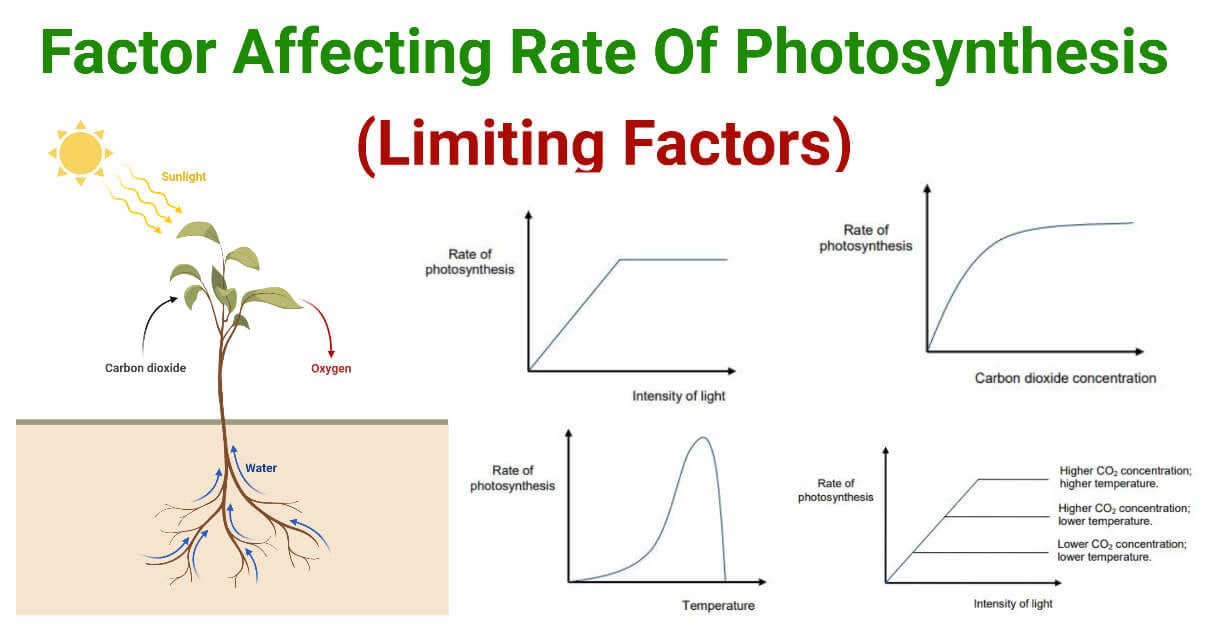
The limiting factors can be divided into two parts:
- External factors – Carbon dioxide, light, water, and temperature.
- Internal Factors – Chlorophyll content, protoplasmic composition, accumulation of by-products, hormones, leaf anatomy and age.
The internal factors do not play an important role as the limiting factors though they do matter and are crucial for the proper functioning of the photosynthetic pathways being carried out.
Interesting Science Videos
What is Photosynthesis?
Photosynthetic is a powerful yet a simple natural process employed by plants and other autotrophic organisms. Organisms make use of sunlight, carbon dioxide, and water to produce oxygen and sugar as a form of energy source. Heterotrophic depend on plants for their energy needs by directly eating them or indirectly by preying on herbivore animals. The photosynthetic process is carried out in the chloroplast organelle of a plant cell.
- The plants first take up carbon dioxide from the surroundings via tiny holes called stomata present in leaves, stems, and other plant parts.
- The water molecules present in the cellular environment in the presence of sunlight are oxidized, hence they lose electrons.
- These electrons are taken up by the carbon dioxide molecules, hence reducing them.
- Six molecules of water (H2O) and six molecules of CO2 come together and react in the sunlight to produce one glucose molecule and six molecules of oxygen.
- 6CO2 + 6H2O + light energy → C6H12O6 + 6O2
- The oxygen molecules are diffused out of the stomata into the environment.
- The glucose molecules serve as energy fuel since the energy stored in them can be harvested via cellular respiration and fermentation processes to generate ATP (adenosine triphosphate) to meet cellular energy needs.
- Photosynthesis helps in Carbon Fixation, where inorganic carbon like CO2 is incorporated into the formation of organic compounds like glucose.
Chloroplast Facts
Chloroplasts are the specialised intracellular organelle that performs photosynthesis in the daytime. The light-absorbing pigments called chlorophyll are present in the thylakoid membrane of the chloroplast. Chlorophyll pigments are responsible for imparting green colours to the plant, algae, and other autotrophic microorganisms. This green colour is achieved by the absorption of blue and red light energy and the transmission of green light waves.
Photosynthesis Limiting Factors
Light as Photosynthesis Limiting Factors
Photosynthesis does not occur in the absence of light, hence there is no photosynthesis during night hours but only during day hours. There are three attributes of sunlight of importance in photosynthesis which includes intensity, quality, and duration of exposure to light.
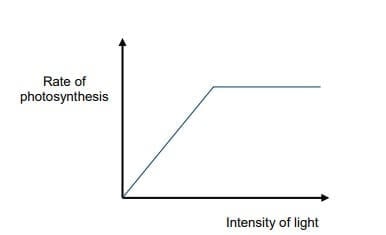
- The intensity of light regulates the rate of the photosynthetic process.
- Photosynthesis initiates at a low light intensity and the rate increases till high-intensity light in bright daylight is reached.
- Even though plants only need 1.5% light to perform photosynthesis, at lower intensities, this can become a limiting factor despite the presence of sufficient carbon dioxide and water.
- Plants kept for a longer period in high-intensity light cause increased transpiration due to a rise in the plant’s internal temperature causing the stomata to close.
- Closed stomata cannot take up CO2 hence reducing photosynthesis. Thus excessive light inhibits photosynthesis.
- If the internal temperature of plants is balanced, the plants exposed to sunlight for a longer duration lead to more photosynthesis.
- Chlorophyll absorbs red and blue wavelengths of light most effectively from the light spectrum.
Carbon Dioxide as Photosynthesis Limiting Factors
Carbon dioxide as a gaseous molecule is very less in the atmosphere with only 0.03% among other atmospheric gases. This causes less availability and scarcity of CO2 for plant consumption, making it a limiting factor for photosynthesis. Experiments have suggested that increasing carbon dioxide concentration causes a photosynthetic rate to increase if light and temperature are not limiting factors. But CO2 starts accumulating after a certain limit and slows down the photosynthetic process and may also inhibit it.
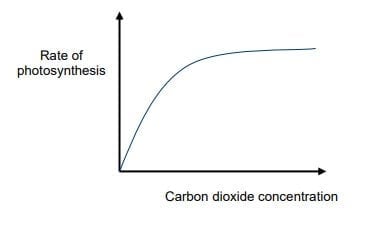
Water as Photosynthesis Limiting Factors
Even though water is abundant in nature but its distribution varies among regions. Their effect is indirect in photosynthesis. When water uptake is low due to less availability, the stomata present in the leaves or stems begin to close to avoid water loss due to transpiration. Closing of stomata leads to reduced carbon dioxide uptake, hence decreasing the rate of photosynthesis.
Temperature as Photosynthesis Limiting Factors
All biochemical and biological processes occur at an optimum range of temperature in all living organisms. Photosynthesis is also a biological process and the photosynthetic rate has been observed to rise over a temperature range of 6 to 37 degrees Celcius. The plant tissues die at 43 degrees Celcius, so there is an abrupt fall in photosynthesis. Higher temperatures also cause the denaturation of proteins, and the inactivation of enzymes involved, alternatively regulating enzymatic dark reaction of photosynthesis. Above 25-30 degrees Celsius, the rate of photosynthesis is reduced.
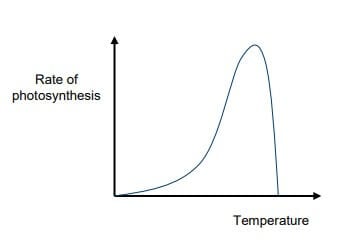
Blackman’s Law of Limiting Factors
Blackman gave the statement that ‘when a process is conditioned as to its rapidity by a number of separate factors, the rate of the process is limited by the pace of the slowest factor.’ This means that when any process is regulated by more than one factor, then the rate of the process will be determined by the factor which has the minimum value among all factors. This minimum value factor is directly proportional to the rate of the process being governed.
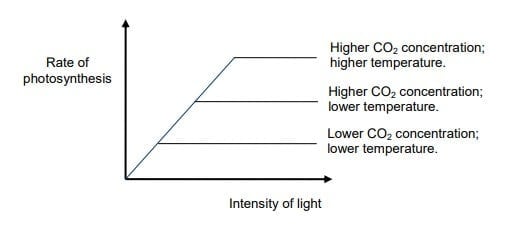
For instance, in the green leaves under optimum light intensity and temperature, with low levels of carbon dioxide concentration, the photosynthesis rate may falter unless optimum CO2 levels are achieved.
Conclusion
Photosynthesis is a biological process that occurs in plants and other autotrophic organisms such as bacteria, algae, etc. In this process, organisms convert light energy to biochemical energy stored in the biomolecules like glucose and carbohydrates to utilize the energy later for cellular processes. Photosynthesis is governed by many factors, some of the important ones include sunlight, carbon dioxide, water, and temperature. Sunlight gives the necessary energy for the oxidoreduction reaction to occur between water and carbon dioxide molecules. The intensity of light determines the rate of photosynthesis. A high-intensity light is observed with a higher photosynthetic rate. Carbon dioxide and water are the main substrates for the photosynthetic reaction and their optimum availability can only lead to sufficient production of end products which are glucose and oxygen. Every biological process works at an optimum temperature, hence photosynthesis also works best at a range of optimum temperatures. All these factors must be present in optimum values for efficient photosynthesis.
References
- Factors Affecting Photosynthesis – https://study.com/learn/lesson/factors-affecting-photosynthesis-overview-equation-examples.html
- Factors Affecting Photosynthesis – https://www.toppr.com/guides/biology/photosynthesis-in-higher-plants/factors-affecting-photosynthesis/
- Factors Affecting Photosynthesis – https://www.slideshare.net/SaajidaSultaana/factors-affecting-photosynthesis-133638530
- https://edu.rsc.org/download?ac=12620
- Intro to photosynthesis – https://www.khanacademy.org/science/ap-biology/cellular-energetics/photosynthesis/a/intro-to-photosynthesi
- Photosynthesis – https://education.nationalgeographic.org/resource/photosynthesis/
- Chloroplast – https://www.britannica.com/science/chloroplast
